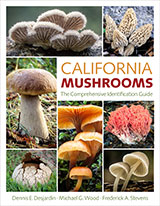Toxic Fungi of Western North America
Dedication
Dedicated to my wife Ellen and my 4 children-Carolyn, Linda, Susan and John. Also in remembrance of Paul Vergeer.
Preface
For cases in which Amanita phalloides or other deadly amatoxic fungi are suspected, go at once to the section titled Guide to the identification of mushroom poisoning by symptoms and, if appropriate, The amatoxic group. For a thumbnail guide to the treatment of amatoxins, go to the end of the discussion on amatoxins to Outline and summary of treatment for poisoning by amatoxins.
See after the main text for a discussion of scientific naming (nomenclature) and scientific classification (taxonomy). Species subject to taxonomic confusion with possibly unstable names are followed by the author citation when they are first mentioned. Citations are appended to all amatoxic species. Citations are customarily abbreviated for some names. One modern standard for author abbreviations is that of P.M. Kirk and A.E. Ansell in 1992. (1a) Two examples are “Fr.” for Elias Fries (cited for the amatoxic Amanita phalloides) and “Bres.” for the Abbé Giacomo Bresadola (cited for the amatoxic Lepiota helveola).
All descriptions of size are given in metric measurements. One inch is 2.54 centimeters or 25.4 millimeters. A centimeter (or 10 millimeters) therefore comes out to about 2/5 of an inch. A 4-inch mushroom cap is roughly 10 centimeters across. Millimeters are very handy for small measurements, replacing the awkward 1/8ths and 1/16ths inches of the English system.
Photographs that were donated for use on this Internet publication are listed following the reference section. Any and all photographs donated to the author by mycologists or other persons are exceptions to our copyright. These remain the intellectual property of the donator, the photographer and/or any other persons or institutions to which they may have been donated.
Acknowledgements
The author would like to thank the following for their support, corrections and much additional information although any errors should be attributed to the above author solely: Dr. Joe Ammirati, Dr. Rodham Tulloss, Michael Wood, Janet Lindgren, Marilyn Shaw, Dr. Denis R. Benjamin, Dr. Else Vellinga, Dr. Kenneth Cochran, Dr. Robert Dummel, Dr. Dennis Desjardin, Dr. Fred Stevens, and Dr. Harry D. Thiers. Special thanks go to Dr. Ammirati for the section on Cortinarius and to Dr. Tulloss for the sections on Amanita and for the examples in taxonomy and nomenclature.

